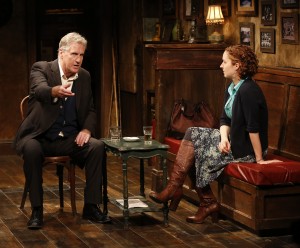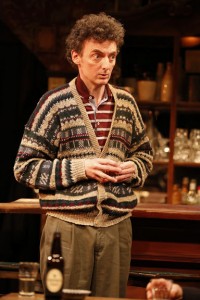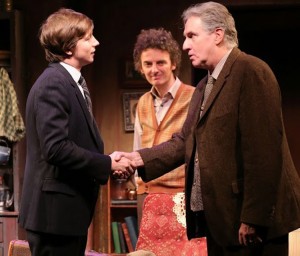Philadelphia, Here I Come, written in the 1960s by Irish playwright Brian Friel, poignantly captures the anticipation, fear, and excitement of emigrating to a new place. Set on the eve of departure, Friel’s play focuses on Gar, the would-be émigré, in both his Public self (played with subdued melancholy by David McElwee) as he struggles with his decision to leave, and his Private self (played with exuberance by A.J. Shively), screaming to get out. It’s deadly boring in Ballybeg, a tiny little corner of County Donegal, Ireland, where the most exciting things are a game of checkers and memories of teenage shenanigans.
Endgame
John Douglas Thompson and Bill Irwin starring in Samuel Beckett’s tragicomic masterpiece Endgame: it’s hard to imagine a more appealing combination. Thompson is perhaps the greatest classical actor of his generation, and Irwin one of the world’s premier interpreters of Beckett, as anyone who witnessed his master class On Beckett (which, like Endgame, played at the Irish Repertory Theatre) can attest. The production, anchored in two brilliant performances and under Ciarán O’Reilly’s precise and elegantly understated direction, exceeds even lofty expectations, perfectly capturing the play’s absurd, macabre comedy without sacrificing its haunting bleakness.
Autumn Royal
There’s a moment early in Kevin Barry’s darkly comic Autumn Royal, currently running at the Irish Rep under the direction of Ciarán O’Reilly, when siblings May (Maeve Higgins) and Timmy (John Keating), both in their 30s in Cork city, Ireland, realize that the current predicament of caring for their psychotic, decrepit, slowly dying father might have no end in sight.
The Shadow of a Gunman
On Aug. 14, 1924, after a third night of sold-out houses at the Abbey Theater in Dublin, inveterate Irish playgoer Joseph Holloway noted in his diary: “The Shadow of a Gunman [has] been staged for three nights with the usual result—that crowds had to be turned away each performance. . . . Certainly [Sean O’Casey] has written the two most popular plays ever seen at the Abbey, and they both are backgrounded by the terrible times we have just passed through, but his characters are so true to life and humorous that all swallow the bitter pill of fact that underlies both pieces.”
Woman and Scarecrow
Irish playwright Marina Carr attempts to capture the thoughts and sentiments of a woman during her last hours alive in Woman and Scarecrow. With skillful direction by Ciarán O’Reilly, this production delves into the innermost feelings of a woman who is learning about the meaning of life at the last possible moment. Carr has chosen to use general character names that could represent anyone, to suggest a universality to the situation: the principals here are Woman, Scarecrow, Him, Aunty Ah and Thing.
Chilled Irish Tales
The very first staging of The Weir at The Royal Court Theatre Upstairs in London shot to almost immediate acclaim, with nascent visionary playwright Conor McPherson winning a Laurence Olivier Award for Best New Play in 1997. Following incarnations of The Weir have starred current TV mainstays Brendan Coyle (of Downton Abbey fame) and Michelle Fairley (as a particularly aggrieved member of the Stark family in Game of Thrones). And The Weir does seem to require the same expressive vocal drama and expository storytelling that television shows afford us. With its extraordinary character appeal and its fascinating series of spine-chilling Irish folktales, the Irish Repertory Theatre's production of The Weir is a darkly bloodcurdling, utterly captivating take on McPherson’s well-crafted play.
Set in a rural Irish pub, bar owner Brendan (a serenely gruff Tim Ruddy) and friendly barflies Jim (John Keating), Jack (Paul O’Brien) and Finbar (Sean Gormley) try to welcome a lovely, mysterious import from Dublin, Valerie (an aptly cast Amanda Quaid), as she acclimates herself to her windy surroundings. The men proceed to tell haunting tales of faeries, poltergeists and abandoned houses, all the while struggling to reconcile their forced bachelorhood with their sudden, protective interest in Valerie—who has an eerie story of her own to tell.
Director Ciaran O’Reilly carefully fleshes out each character through the exquisite exposition of each individual story, courtesy of McPherson’s chillingly arresting words. Somehow, distinctly Irish turns of phrase possess an earthy accessibility under his pen, as well as a surprising amount of humor. There is an understated, rugged comradeship that the men share in their familiar curses and ubiquitous swigs of Guinness. The Irish flavor of it all is surpassingly delightful, as are the fantastical folktales borne out of that stout-and-song tradition; McPherson deftly paints his characters as traumatic products of their stories, and it’s difficult to distract yourself from their beguiling eeriness.
Valerie’s tale holds a deep, desperately weary grief. Jack’s dual yarns of a coldly enchanting faerie adventure and a haunting lost love both possess an expertly gleeful, then progressively sorrowful mannerism. Perhaps most harrowing are Jim and Finbar’s stories, for different reasons; an endearingly odd Keating imbues Jim with a trembling, wide-eyed respect for the supernatural, while Gormley’s Finbar is an uneasy skeptic, begrudgingly honest in his retelling of an eerie encounter, but steadfastly refusing to believe in anything out of the ordinary. But it is O’Brien’s gruff, garrulous take on Jack that gives the entire production that heady, hallucinatory magic. He keenly modulates the volume of his voice—whispering at climaxes and chuckling in practice disbelief—until it becomes an actor all its own. The back-from-hiatus (and excellent) Tim Ruddy makes us wonder why Brendan is still a bachelor.
Ciaran O’Reilly has woven each of these character’s stories with some unknowable alchemy. Even as a single actor seems to commandeer the stage with his or her tale, a magnificent change comes over their compatriots on stage: they become the audience. We are mirrored in their slack faces and uneasy composures; just as the seated audience writhes inwardly against our collective imaginations when Valerie narrates her ghostly tale, Jack, Jim, Brendan and Finbar cannot move. A magnificent design and sound/light team induce much of the trance-like state the audience enjoys.
Courtesy of scenic designer Charlie Corcoran, the bar room is a study in light and dark browns, cleverly synthesizing the homey, fire-crackling hearth ambiance perfect for storytelling. The lighting by Michael Gottlieb is an understated marvel dimming almost indiscernibly during the narrative sequences. During these instances, the audience hears a hollow, equally imperceptible whistling of wind, perhaps the most effective minimalist contribution to the play, overseen by Drew Levy. But the actors’ voices are so spellbinding that the whistling seems an organic soundtrack to their story.
The Weir ends much too quickly and the actors’ final exit leaves us with an irrational hope that they might come back on stage and tell us their hauntingly beautiful tales in their seductive Irish slang once more. Instead, we hear the familiar refrain of good luck, as Jack was accustomed to say before downing a pint, and the companionable reminder of the power of storytelling. In the end, when McPherson’s words have run out, we are left with a sweet, silent ache for some similar kind of chilling magic.
The Weir ran until Sept. 3 at The Irish Repertory Theatre at the DR2 Theatre (103 East 15th St. between Union Square East and Irving Pl.) in Manhattan. For more information, visit www.irishrep.org.
Life with Father, Irish Style
Hugh Leonard’s Da is a painful coming-of-age story being given an engaging and rare revival by the Irish Repertory Theater in its temporary home at DR2 Theatre off Union Square.
Set in a rural town in Ireland, Leonard’s 1978 Tony winner deals with Charlie, a middle-aged man who has returned to his family home after the death of his father. The memories he has are painful, and it’s clear immediately in Charlotte Moore’s production that Charlie feels some relief at the recently severed tie to his father. But Da isn’t done with his son: his ghost, a boisterous and peremptory Paul O’Brien, shows up to harangue and browbeat Charlie. And Charlie, for his part, feels resentments bubble up in him once again. As the play unfolds, one learns about the origins of their friction, as well as Charlie’s adolescence and working life. He is, in fact, an adoptive son to Da and his Ma (Fiana Toibin).
Clues come early on about how difficult Charlie’s life was, as the family prepares for the arrival of a Mr. Drumm who will interview Charlie for a job. There’s a battle over the shirt that Charlie is supposed to wear. (Adam Petherbridge plays the younger Charlie with a mixture of rebellion and Catholic guilt, while Ciarán O’Reilly shines as the more confident and calmer adult observing his life.) He doesn’t want to wear the one that his mother has patched, and his resistance causes a squabble and earns him a slap.
After Sean Gormley’s thin-lipped, priggish Mr. Drumm arrives, Da, though warned to speak minimally, launches into praise of Hitler. (Some Irishmen supported Hitler because he was at war with their historical enemy, England.) Drumm, judgmental and bloodless, has nothing but contempt for Da, and he expresses it bluntly. Drumm offers Charlie a job nonetheless, with the warning that he shouldn’t stay in it too long—a warning that Charlie, a budding writer, doesn’t heed for more than a decade. A nice irony is that Drumm, unsusceptible to sentiment, gives Charlie sounder advice than his parents offer: “You’ll amount to nothing until you learn to say no.”
Leonard’s story slips from memory to the present and back, sometimes a bit strangely: older Charlie doesn’t merely watch his younger self in scenes—they converse about what’s going on, with the older self advising the younger. O’Brien’s Da is by turns morose, cheerful, overbearing, and proud, and it’s clear he will never be a figure his son will worship. In spite of the cozy warmth suggested by James Morgan’s crockery-filled parlor, this autobiographical play is also rife with unhappiness, stupidity, and emotional abuse.
Leonard’s rich language— “Old faces. They’ve turned up like bills you thought you’d never have to pay”—gets full weight from an excellent cast. Although men are the focus, two actresses in smaller parts make the most of their single scenes. Nicola Murphy plays Mary Tate, a reputed good-time girl that Charlie wants but who has more sweetness than he appreciates. Petherbridge is terrific in the scene, alternately bashful and on the make, and Murphy brings true poignancy to poor Mary, initially aloof, then warming to Charlie’s charms. It’s to Leonard’s credit that Charlie, his own stand-in, comes off poorly. As Da’s employer of decades, Kristin Griffith arrives late in the play to deliver a clueless, insulting pittance to the man who has served as her gardener for years, while she eagerly gathers the bounty he has cultivated. Da is ever the apologist for his poor treatment, too proud to claim more than others are willing to give him, and that gripes the older Charlie. It undoubtedly reflects Leonard’s own struggle to find confidence in himself that he is never destined to receive from either father or mother. Yet, as Charlie finally learns, "Love turned upside down is love for all that."
Performances of Da by the Irish Repertory Theatre take place through March 8 at the DR2 Theatre at 103 E. 15th St., off Union Square. Evening curtains are at 7 p.m. Tuesdays and Thursdays and 8 p.m. Wednesdays, Fridays and Saturdays. Matinees are at 3 p.m. on Saturdays and Sundays.















